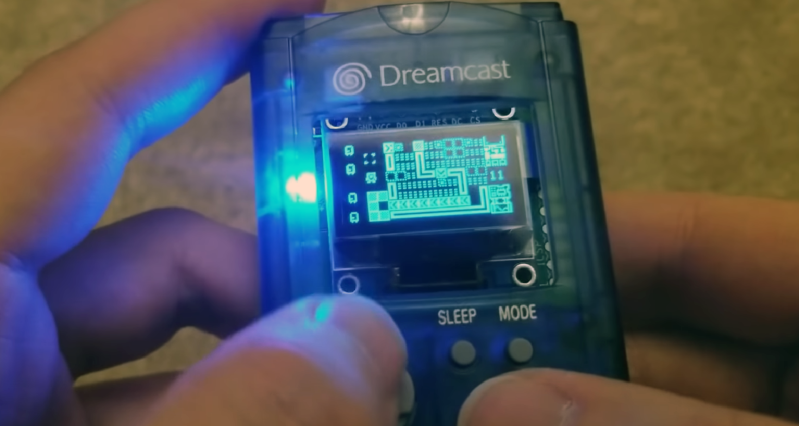The Arduboy is a tiny, credit-card sized sized video game console that you can build yourself. The Dreamcast VMU was also a tiny, pocketable video game system, but really that’s just where we stored our saves for Crazy Taxi. What do you get when you combine the two? [sjm] did just that, giving us an Arduboy tucked into a Dreamcast VMU.
The guts of the Arduboy is simply an ATMega32u4, the same chip found in many Arduinos, an I2C OLED, and a few other various electronics for USB, power, and battery protection. In short, it’s an easy circuit, and something just about anyone with the skills can build themselves. Since just anyone can get a PCB fabbed, and the Dreamcast already has nice silicone buttons built into the enclosure, it was a simple matter for [sjm] to create a Dreamcast VMU-shaped PCB with all the guts of an Arduboy. The only real difference is the size of the OLED — this one uses a 0.96″ 128×64 OLED, where the original used one with the same resolution but with a significantly larger size.
Yes, we’ve seen this same project before, but now thanks to the magic of the Hackaday Prize, it’s now in the running for the greatest hardware competition on the planet. You can check out the entire build video and a short demo after the break. Of course, this isn’t the first repurposing of the Arduboy circuit, we’ve seen a flex circuit version, and a version with a crank like the Playdate developed by Teenage Engineering and Panic.



















@Brian Benchoff, typo in the headline: “Aruboy”
Got it.
I don’t need pull-up resistors for membrane buttons?
The Arduboy games (basically just an Atmega microcontroller program) configure the button inputs to use internal pullups so there’s no need to have external ones
Thanks for your reply. BTW I like your youtube channel. ;)
If anyone is interested in that game for the Arduboy, it’s called Circuit Dude. :) I made it. Sorry. :P
Hi Crait, fancy meeting you here!
OLED is SPI, not I2C AFAIK. Seems like several people have found their own DIY Arduboy builds complicated by buying an I2C OLED module.
I used to love the VMU purely for football as you could actually secretly choose plays without your competitor seeing your screen choices. Perfect for this project and glad to see they live on! Still waiting for a Seaman PC port as I had no luck with emus and the mic. If someone has, please let me know!
An even better hack would be to have it still function as a Dreamcast VMU.
Would it count if he ran a VMU emulator on it? https://community.arduboy.com/t/sega-homebrew/4528
I documented the protocol and provide the code – the rest is left as an exercise to the reader
All I hope is that you didn’t destroy a functional VMU just to add an Arduino to it :(